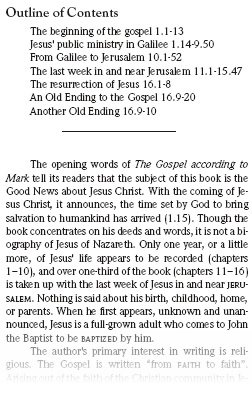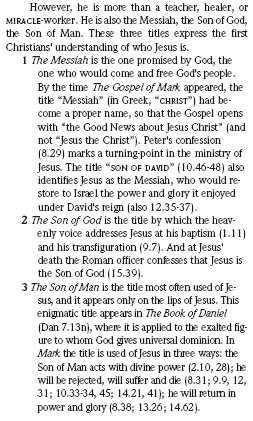Extended Book Introductions¶
Extended or alternative book introduction text should replace any existing book introduction text from the base scripture translation text. Any USFM identification (metadata) elements (\h, \toc1, \toc2, \toc3), main title(s), introduction elements, and table elements can be included within the extended book introduction.
Text and Formatting Samples
Introduction Outline; Paragraphs - Introduction to Mark (GNSB)
\id MRK - Good News Study Bible - Notes Material
\iot Outline of Contents
\io1 The beginning of the gospel 1.1-13
\io1 Jesus' public ministry in Galilee 1.14-9.50
\io1 From Galilee to Jerusalem 10.1-52
\io1 The last week in and near Jerusalem 11.1-15.47
\io1 The resurrection of Jesus 16.1-8
\io1 [An Old Ending to the Gospel 16.9-20]
\io1 [Another Old Ending 16.9-10]
\ip The opening words of \bk The Gospel according to Mark\bk* tell its readers that the
subject of this book is the Good News about Jesus Christ. With the coming of Jesus Christ,
it announces, the time set by God to bring salvation to humankind has arrived (1.15).
Though the book concentrates on his deeds and words, it is not a biography of Jesus of
Nazareth. Only one year, or a little more, of Jesus' life appears to be recorded (chapters
1--10), and over one-third of the book (chapters 11--16) is taken up with the last week of
Jesus in and near \w Jerusalem\w*. Nothing is said about his birth, childhood, home, or
parents. When he first appears, unknown and unannounced, Jesus is a full-grown adult who
comes to John the Baptist to be \w baptized\w* by him.
\ip The author's primary interest in writing is religious. The Gospel is written "from
\w faith\w* to faith". ...

Introduction Section - Introduction to Mark (GNSB)
\is1 The Story
\ip \bk Mark's\bk* story of Jesus is told quickly and with an abundance of details that
enhance its dramatic impact. Jesus appears suddenly in Judea, where he joins those who
are being baptized in the Jordan by John the Baptist. Just as suddenly, he returns to
Galilee, where he proclaims the message that the \w kingdom of god\w* is about to
arrive...

Introduction List - Introduction to Mark (GNSB)
\ip However, he is more than a teacher, healer, or \w miracle\w*-worker. He is also the
Messiah, the Son of God, the Son of Man. These three titles express the first Christians'
understanding of who Jesus is.
\ili 1 \k The Messiah\k* is the one promised by God, the one who would come and free God's
people. By the time \bk The Gospel of Mark\bk* appeared, the title "Messiah" (in Greek,
"\w christ\w*") had become a proper name, so that the Gospel opens with "the Good News
about Jesus Christ" (and not "Jesus the Christ"). Peter's confession (8.29) marks a
turning-point in the ministry of Jesus. The title "\w son of david\w* " (10.46-48) also
identifies Jesus as the Messiah, who would restore to Israel the power and glory it
enjoyed under David's reign (also 12.35-37).
\ili 2 \k The Son of God\k* is the title by which the heavenly voice addresses Jesus at
his baptism (1.11) and his transfiguration (9.7). And at Jesus' death the Roman officer
confesses that Jesus is the Son of God (15.39).
\ili 3 \k The Son of Man\k* is the title most often used of Jesus, and it appears only on
the lips of Jesus. This enigmatic title appears in \bk The Book of Daniel\bk* (Dan 7.13n),
where it is applied to the exalted figure to whom God gives universal dominion. In
\bk Mark\bk* the title is used of Jesus in three ways: the Son of Man acts with divine
power (2.10, 28); he will be rejected, will suffer and die (8.31; 9.9, 12, 31; 10.33-34,
45; 14.21, 41); he will return in power and glory (8.38; 13.26; 14.62).
